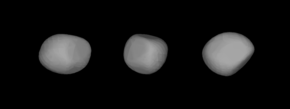
Back 54 Alexandra (كويكب) ARZ 54 Alexandra AST (54) Аляксандра Byelorussian (54) Alexandra Catalan (54) Александра CE Alexandra (planetka) Czech (54) Alexandra German 54 Αλεξάνδρα Greek 54 Alexandra Esperanto (54) Alexandra Spanish
 A three-dimensional model of 54 Alexandra based on its light curve | |
| Discovery[1] | |
|---|---|
| Discovered by | H. Goldschmidt |
| Discovery date | 10 September 1858 |
| Designations | |
| (54) Alexandra | |
| Pronunciation | /ˌælɪɡˈzændrə, -ˈzɑːn-/ AL-ig-ZA(H)N-drə[2] |
Named after | Alexander von Humboldt (German explorer) |
| Main belt | |
| Adjectives | Alexandrian |
| Orbital characteristics | |
| Epoch December 31, 2006 (JD 2454100.5) | |
| Aphelion | 485.483 Gm (3.245 AU) |
| Perihelion | 326.043 Gm (2.179 AU) |
| 405.763 Gm (2.712 AU) | |
| Eccentricity | 0.196 |
| 1,631.620 d (4.47 a) | |
| 103.809° | |
| Inclination | 11.804° |
| 313.446° | |
| 345.594° | |
| Physical characteristics | |
| Dimensions | 160 × 135 km (± 1 km) |
| 154.137 km[1] | |
| Mass | (6.16±3.50)×1018 kg[3] |
Mean density | 3.50±2.11 g/cm3[3] |
| 18.14 h[4] | |
Pole ecliptic latitude | 155°±4°[5] |
Pole ecliptic longitude | 17°±3°[5] |
| 0.056[1][6] | |
| Tholen = C [1] SMASS = C [1] | |
| 7.66[1] | |
Alexandra (minor planet designation: 54 Alexandra) is a carbonaceous asteroid from the intermediate asteroid belt, approximately 155 kilometers in diameter. It was discovered by German-French astronomer Hermann Goldschmidt on 10 September 1858, and named after the German explorer Alexander von Humboldt; it was the first asteroid to be named after a male.[7]
- ^ a b c d e f Cite error: The named reference
jpldatawas invoked but never defined (see the help page). - ^ "Alexandra". Lexico UK English Dictionary. Oxford University Press. Archived from the original on 22 March 2020.
"Alexandra". Dictionary.com Unabridged (Online). n.d. - ^ a b Cite error: The named reference
Carry2012was invoked but never defined (see the help page). - ^ Cite error: The named reference
Belskaya1993was invoked but never defined (see the help page). - ^ a b Cite error: The named reference
Hanus2017was invoked but never defined (see the help page). - ^ "Asteroid Data Sets". Archived from the original on 17 December 2009. Retrieved 12 January 2007.
- ^ Cite error: The named reference
Schmadel2003was invoked but never defined (see the help page).
© MMXXIII Rich X Search. We shall prevail. All rights reserved. Rich X Search